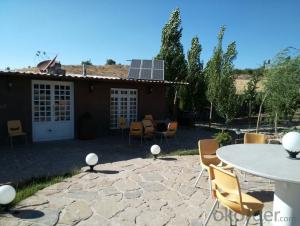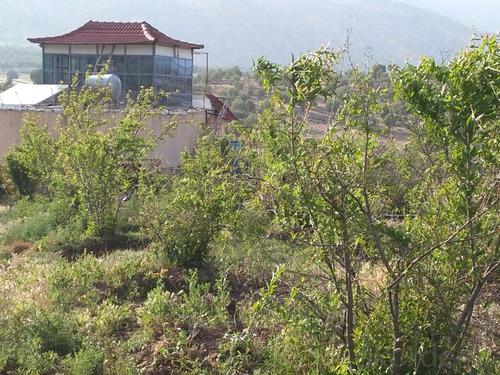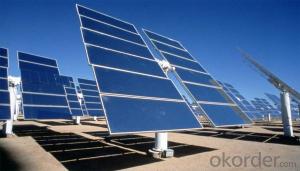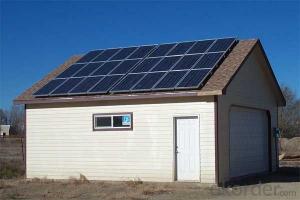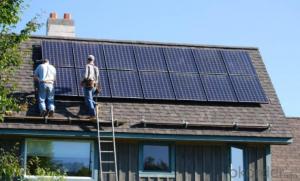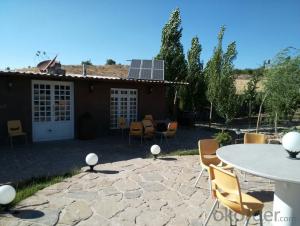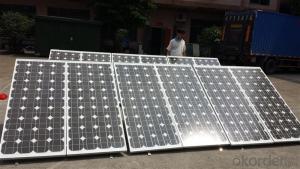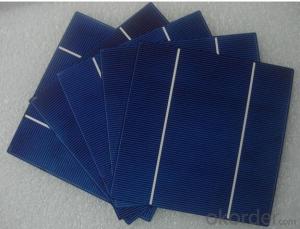Off-Grid Solar Power System 3KW High Efficiency
- Loading Port:
- China main port
- Payment Terms:
- TT OR LC
- Min Order Qty:
- 1 pc
- Supply Capability:
- 10000 pc/month
OKorder Service Pledge
OKorder Financial Service
You Might Also Like
1.Description of Product
Off-Grid Solar Power System is consisted of solar panel, solar charge controller, inverter, battery, mounting rack and cables.
(1).Grid-connected, send power to city grid
(2).MPPT technology, wide range of working voltage
(3).Simply Wiring, easy installation, customized design for your projects
(4).Low investment & long term feedback
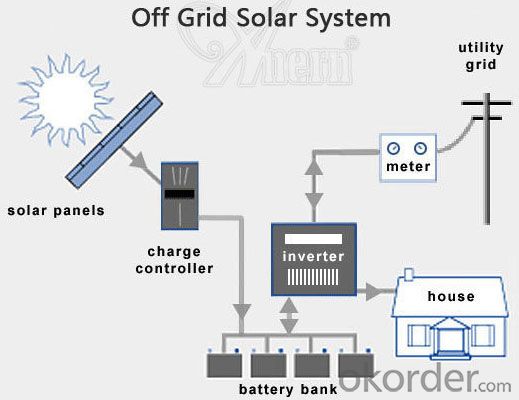
2. Off-Grid Features
1. Off grid solar power system is mainly used for application with relatively-small power consumption, and the areas have no grid network coverage, or grid power is unstable or outage condition.
2. It’s composed of solar panels, hybrid solar inverter, battery bank, solar panel mounting racks, and other accessories required fora complete home solar power system.
3. The battery bank gives a stable power output to the solar inverter which converts DC to AC to power loads, and provides power backup in rainy or cloudy days.
4. The solar panels generate electricity at daytime and charge the battery bank .
5. The off grid home solar power system provides grid power bypass in case of battery power shortage when sunshine is not enough.
6. All the off grid home solar power system configurations are worked out by scientific calculation and design.
The Product Parameter | |
Ref No. | 3KW |
Solar Panel | Type: Monocrystalline Silicon PV Module Max Power: 250W QTY:8 pcs |
Controller-Inverter Integrator | Rated Ouput Power: 3000W Rated DC Voltage: 48V QTY:1 pcs |
Battery | 12V/200AH per piece QTY:8 pcs |
Solar Panel Rack | Roof type mounting rack, anodized aluminum material, including complete fittings (Other type of racks can be customized as per client's requirement) QTY:1 pcs |
Cables | International standard, with specification suitable for solar system, BV1*10 QTY:60m |
3.The Pictures of Product
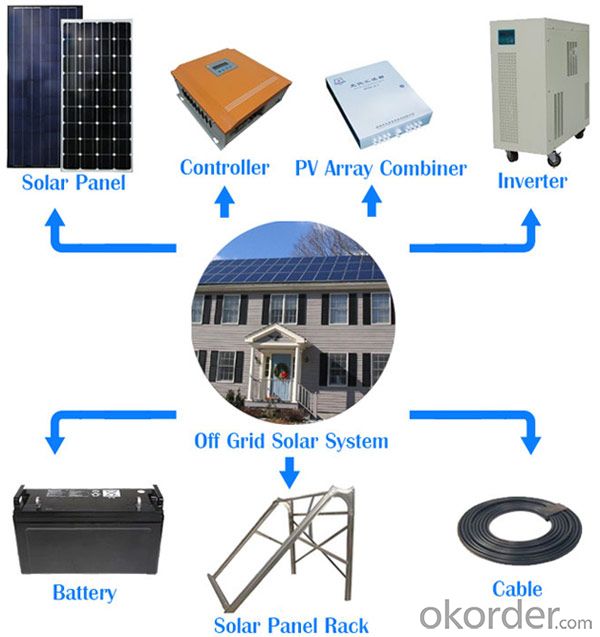
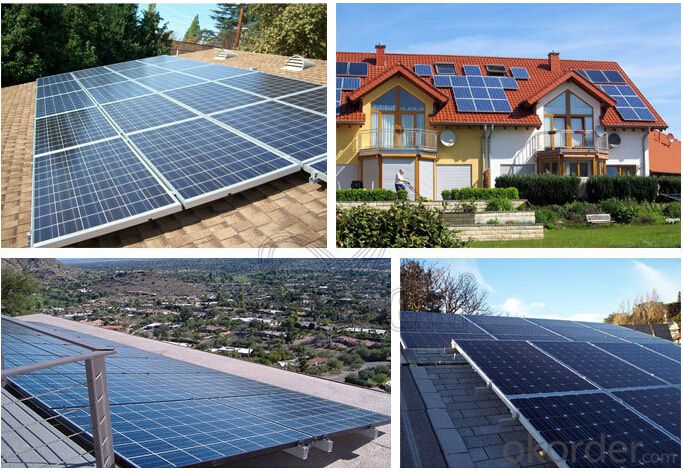
4.FAQ
Q1: What is the business type for the company?
A1: We are one of the biggest manufacturers inBejing.Chnia. Which is a high tech PV enterprise dedicated to the research, development, production and sales..
Q2: How long solar panel warranty can you offer?
A2: 10-Year product warranty,25-year linear power output warranty
If there is any quality problem, we will pay for freight and send free parts to you.
Q3: How many certificates do you have?
A3: We have 16 certificates,such as CE, TUV, UL, and so on.
Q4: Can I be the agent for you?
A4: Yes,We can discuss some information.
Q5: How to get a sample?How can cooperation with us
A5: contact us now.
- Q: How does temperature affect the efficiency of solar panels?
- Temperature affects the efficiency of solar panels by causing a decrease in their overall performance. As the temperature rises, the efficiency of solar panels decreases due to the negative thermal coefficient of their photovoltaic cells. This means that as the temperature increases, the voltage output of the cells decreases, resulting in a reduction in the power generated by the panels.
- Q: Can solar energy systems be used in areas with limited access to solar energy insurance coverage?
- Yes, solar energy systems can still be used in areas with limited access to solar energy insurance coverage. While insurance coverage may provide financial protection in case of damage or malfunction, it is not a requirement for the installation and operation of solar energy systems. However, it is advisable to thoroughly assess potential risks and consider alternative risk management strategies in the absence of proper insurance coverage.
- Q: Are there any insurance requirements for installing a solar energy system?
- Installing a solar energy system comes with insurance requirements that vary depending on location and circumstances. It is generally advised to have proper insurance coverage in place to protect your investment and provide financial security in case of unexpected damages or accidents. Property insurance is a common requirement for solar energy systems. It covers damage or loss to the physical components like solar panels, inverters, and batteries, protecting against risks such as fire, theft, vandalism, and natural disasters. Along with property insurance, liability insurance is often necessary. This coverage protects you from legal claims that may arise from accidents or injuries during installation or operation. It may also cover damage to neighboring properties. If you are financing the system through a loan or lease, the lender or leasing company may have specific insurance requirements, including coverage limits, additional insured endorsements, or preferred insurance providers. To ensure proper coverage, consult with your insurance provider and solar installer. They can guide you through location-specific requirements and recommendations based on your individual circumstances.
- Q: Are there any government incentives or rebates for installing solar energy systems?
- Yes, there are government incentives and rebates available for installing solar energy systems. These incentives vary by country and region, but they often include tax credits, grants, and rebates that aim to encourage the adoption of renewable energy sources like solar power. These incentives can help offset the upfront costs of installation and make solar energy systems more affordable for homeowners and businesses. It is recommended to check with local authorities or renewable energy agencies to learn about specific incentives available in your area.
- Q: Do solar energy systems work at night?
- At night, solar energy systems are unable to function due to their reliance on sunlight for the generation of electricity. Through the photovoltaic effect, solar panels transform sunlight into electricity by dislodging electrons from atoms with photons from the sun's rays, thus establishing an electric current. The absence of sunlight results in the absence of an energy source to sustain the system. Nevertheless, it is important to note that certain solar energy systems possess the capability to store surplus energy generated during the day in batteries, enabling the utilization of this stored energy for operating appliances or lighting during the night.
- Q: Can solar energy systems be installed on roofs?
- Yes, solar energy systems can be installed on roofs. In fact, rooftops are one of the most common locations for installing solar panels. The main advantage of installing solar panels on roofs is that they utilize the existing space without requiring any additional land. Rooftop solar installations are also advantageous because they are usually unobstructed by shading from trees or buildings, resulting in optimal sun exposure for generating electricity. Additionally, rooftop installations are often cost-effective as they can reduce the need for long-distance transmission lines and can directly supply power to the building they are installed on. Overall, installing solar energy systems on roofs is a practical and efficient way to harness clean and renewable energy.
- Q: Are solar energy systems noisy?
- No, solar energy systems are not noisy. They operate silently as they convert sunlight into electricity without any moving parts or mechanical components.
- Q: What are the main components of a solar energy system?
- The main components of a solar energy system include solar panels, an inverter, a charge controller, batteries (if it's an off-grid system), and a power meter (if it's an on-grid system).
- Q: Solar power generation system suitable for home, how much is the cost of a set?
- Solar photovoltaic power generation is suitable for families but to look at your location and sunshine time, before the country without a policy or honest with general electric, energy saving is a national matter we the people pay so without saving
- Q: Are there any tax benefits for installing a solar energy system?
- Yes, there are several tax benefits for installing a solar energy system. One of the main benefits is the federal investment tax credit (ITC). The ITC allows homeowners and businesses to deduct a percentage of the cost of their solar energy system from their federal taxes. As of 2021, the ITC provides a 26% tax credit for residential systems and commercial systems. Additionally, some states offer their own tax incentives for solar energy installations. These incentives may include property tax exemptions, sales tax exemptions, or state tax credits. The availability and amount of these incentives vary from state to state, so it is important to research the specific incentives available in your area. Furthermore, installing a solar energy system can also increase the value of your property. Several studies have shown that homes with solar panels sell for a premium compared to homes without them. This increase in property value can have long-term financial benefits. It is recommended to consult with a tax professional or an expert in solar energy to fully understand and take advantage of all the tax benefits available for installing a solar energy system.
Send your message to us
Off-Grid Solar Power System 3KW High Efficiency
- Loading Port:
- China main port
- Payment Terms:
- TT OR LC
- Min Order Qty:
- 1 pc
- Supply Capability:
- 10000 pc/month
OKorder Service Pledge
OKorder Financial Service
Similar products
Hot products
Hot Searches
Related keywords

